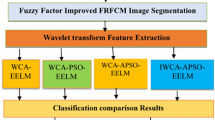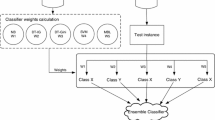Abstract
Ensemble learning has piqued the curiosity of the machine learning applications. It recently drawn serious attention in computer-aided diagnostic system (CADs) due to their potential to significantly increase the prediction performance, especially in mass classification in the mammogram. The ensemble pruning technique is used to reduce the ensemble size and improve its performance by selecting an optimal subset from a pool of individual classifiers. Among ensemble pruning techniques, the metaheuristic Bees algorithm (BA) showed reliable performance in terms of the selected ensemble's accuracy. However, BA's random initialization cannot guarantee whether the optimal ensemble will be selected, which leads to lesser classification results. Thus, this study introduces a selective Random Start Best step (RSB) initialization for BA to get an optimal ensemble pruning solution. Moreover, fusing ensemble members with equal weights will reduce the performance of the ensemble. To overcome this issue, a Local Weighted Majority Voting (L-WMV) is proposed beside the RSB. The proposed RSB(L-WMV) method for solving ensemble pruning and fussing issues was assessed on the mammogram image dataset that has been collected from Hospital Kuala Lumpur (HKL). Furthermore, the proposed RSB(L-WMV) was applied to the Mammographic Image Analysis Society (MIAS) benchmark dataset to show the proposed method's effectiveness. The obtained results using various evaluation metrics (accuracy, sensitivity, specificity, AUC) reveal the superiority of the proposed RSB(L-WMV) compared to similar methods in the literature.


















Similar content being viewed by others
References
Sung H, Ferlay J, Siegel RL, Laversanne M, Soerjomataram I, Jemal A, Bray F (2021) Global cancer statistics 2020: GLOBOCAN estimates of incidence and mortality worldwide for 36 cancers in 185 Countries. CA Cancer J Clin 71:209–249
WHO (2020) Breast Fact Sheet. Int Agency Res Cancer, World Heal Organ. https://doi.org/10.1016/B978-0-323-47912-7.00010-X
Monticciolo DL, Newell MS, Hendrick RE, Helvie MA, Moy L, Monsees B, Kopans DB, Eby PR, Sickles EA (2017) Breast cancer screening for average-risk women: recommendations from the ACR commission on breast imaging. J Am Coll Radiol 14:1137–1143
Kumar V (2020) Evaluation of computationally intelligent techniques for breast cancer diagnosis. Neural Comput Appl. https://doi.org/10.1007/s00521-020-05204-y
Yassin NIR, Omran S, El Houby EMF, Allam H (2018) Machine learning techniques for breast cancer computer aided diagnosis using different image modalities: a systematic review. Comput Methods Programs Biomed 156:25–45
Rahman A, Muniyandi R, Albashish D (2021) Artificial neural network with Taguchi method for robust classification model to improve classification accuracy of breast cancer. PeerJ Comput Sci 7:1–27
Oskouei MD, Razavi SN (2018) An ensemble feature selection method to detect web spam. Asia-Pacific J Inf Technol Multimed 7:99–113
Chang C, Srinivasan K, Hu H-Y, Tsai Y-S, Sharma V, Agarwal P (2020) SFFS – SVM based prostate carcinoma diagnosis in DCE - MRI via ACM segmentation. Multidimens Syst Signal Process 31:689–710. https://doi.org/10.1007/s11045-019-00682-3
Chang CY, Srinivasan K, Chen MC, Chen SJ (2020) SVM-enabled intelligent genetic algorithmic model for realizing efficient universal feature selection in breast cyst image acquired via ultrasound sensing systems. Sensors (Switzerland). https://doi.org/10.3390/s20020432
Chang C-Y, Srinivasan K, Chen S-J, Chang M-S, Sharma V (2018) An Efficient SVM based lymph node classification approach using intelligent communication ant colony optimization. J Med Imag Heal Informatics 8:1077–1086. https://doi.org/10.1166/jmihi.2018.2411
Albashish D, Sahran S, Abdullah A, Shukor NA, Pauzi S (2016) Ensemble learning of tissue components for prostate histopathology image grading. Int J Adv Sci Eng Inf Technol 6:1134–1140
Shakeel PM, Burhanuddin MA, Desa MI (2020) Automatic lung cancer detection from CT image using improved deep neural network and ensemble classifier. Neural Comput Appl. https://doi.org/10.1007/s00521-020-04842-6
Shakeel PM, Tolba A, Al-Makhadmeh Z, Jaber MM (2020) Automatic detection of lung cancer from biomedical data set using discrete AdaBoost optimized ensemble learning generalized neural networks. Neural Comput Appl 32:777–790
Qasem A, Abdullah SNHS, Sahran S, Albashish D, Arasaratnam S (2018) Heterogeneous ensemble pruning based on bee algorithm for mammogram classification. Int J Adv Comput Sci Appl 9:231–239
Rahmani Seryasat O, Haddadnia J (2017) Evaluation of a new ensemble learning framework for mass classification in mammograms. Clin Breast Cancer 18:e407–e420
Zhou ZH, Wu J, Tang W (2002) Ensembling neural networks: many could be better than all. Artif Intell 137:239–263
Xing HJ, Wang XZ (2017) Selective ensemble of SVDDs with Renyi entropy based diversity measure. Pattern Recognit 61:185–196
Dai Q, Ye R, Liu Z (2017) Considering diversity and accuracy simultaneously for ensemble pruning. Appl Soft Comput J 58:75–91
Choi JY, Kim DH, Plataniotis KN, Ro YM (2016) Classifier ensemble generation and selection with multiple feature representations for classification applications in computer-aided detection and diagnosis on mammography. Expert Syst Appl 46:106–121
Zeng X, Wong DF, Chao LS (2014) Constructing better classifier ensemble based on weighted accuracy and diversity measure. Sci World J. https://doi.org/10.1155/2014/961747
Cavalcanti GDC, Oliveira LS, Moura TJM, Carvalho GV (2016) Combining diversity measures for ensemble pruning. Pattern Recognit Lett 74:38–45
Guo H, Liu H, Li R, Wu C, Guo Y, Xu M (2018) Margin & diversity based ordering ensemble pruning. Neurocomputing 275:237–246
Bian Y, Wang Y, Yao Y, Chen H (2020) Ensemble pruning based on objection maximization with a general distributed framework. IEEE Trans Neural Networks Learn Syst 31:3766–3774
Zhou ZH, Tang W (2003) Selective ensemble of decision trees. Lect Notes Comput Sci (Includ Subser Lect Notes Artif Intell Lect Notes Bioinform) 2639:476–483
Guo H, Sun F, Cheng J, Li Y, Xu M (2016) A novel margin-based measure for directed hill climbing ensemble pruning. Math Probl Eng. https://doi.org/10.1155/2016/3845131
Pham DT, Ghanbarzadeh A, Koç E, Otri S, Rahim S, Zaidi M (2006) The bees algorithm - a novel tool for complex optimisation problems. Intell Prod Mach Syst 65:454–459
Zhao J, Jiao L, Xia S, Basto Fernandes V, Yevseyeva I, Zhou Y, Emmerich M (2018) Multiobjective sparse ensemble learning by means of evolutionary algorithms. Decis Support Syst 111:86–100
Polikar R (2006) Ensemble based systems in decision making. IEEE Circuits Syst Mag 6:21–44
Combi C, Shahar Y, Abu-Hanna A (2009) Lecture Notes in Artificial Intelligence in Medicine. 12th Conf. Artif. Intell. Med. AIME 2009 Verona, Italy, July 18–22, 2009
Ekbal A, Saha S (2010) Classifier ensemble selection using genetic algorithm for named entity recognition. Res Lang Comput 8:73–99
Swiderski B, Osowski S, Kurek J, Kruk M, Lugowska I, Rutkowski P, Barhoumi W (2017) Novel methods of image description and ensemble of classifiers in application to mammogram analysis. Expert Syst Appl. https://doi.org/10.1016/j.eswa.2017.03.031
Vijayan D, Lavanya R (2021) Ensemble of density-specific experts for mass characterization in mammograms. Signal, Image Video Process 15:1011–1019
Bhosle U, Deshmukh J (2019) Mammogram classification using AdaBoost with RBFSVM and Hybrid KNN–RBFSVM as base estimator by adaptively adjusting γ and C value. Int J Inf Technol 11:719–726
Malebary SJ, Hashmi A (2021) Automated breast mass classification system using deep learning and ensemble learning in digital mammogram. IEEE Access 9:55312–55328
Rampun A, Scotney BW, Morrow PJ, Wang H (2018) Breast mass classification in mammograms using ensemble convolutional neural networks. In: IEEE 20th Int. Conf. e-Health Networking, Appl. Serv. IEEE, pp 1–6
Esener II, Ergin S, Yuksel T (2017) A new feature ensemble with a multistage classification scheme for breast cancer diagnosis. Hindawi J. Healthc. Eng. 2017:
Hosni M, Abnane I, Idri A, Carrillo de Gea JM, Fernández Alemán JL (2019) Reviewing ensemble classification methods in breast cancer. Comput Methods Programs Biomed 177:89–112
Tsoumakas G, Partalas I, Vlahavas I (2009) An ensemble pruning primer. Appl supervised unsupervised ensemble methods Springer, Berlin, Heidelb 1–13
Xia X, Lin T, Chen Z (2017) Maximum relevancy maximum complementary based ordered aggregation for ensemble pruning. Appl Intell 36:1–12
Li D, Wen G (2018) MRMR-based ensemble pruning for facial expression recognition. Multimed Tools Appl 77:15251–15272
Alzubi OA, Alzubi JA, Alweshah M, Qiqieh I, Al-Shami S, Ramachandran M (2020) An optimal pruning algorithm of classifier ensembles: dynamic programming approach. Neural Comput Appl. https://doi.org/10.1007/s00521-020-04761-6
Chu J (2017) A novel computer-aided diagnosis system for breast MRI based on feature selection and ensemble learning. Comput Biol Med 83:157–165
Ruta D, Gabrys B (2005) Classifier selection for majority voting. Inf Fusion 6:63–81
Choi JY, Kim DH, Plataniotis KN, Ro YM (2012) Combining multiple feature representations and AdaBoost ensemble learning for reducing false-positive detections in computer-aided detection of masses on mammograms. Proc Annu Int Conf IEEE Eng Med Biol Soc EMBS 25:4394–4397
Pham DT, Castellani M (2009) The bees algorithm: modelling foraging behaviour to solve continuous optimization problems. Proc Inst Mech Eng Part C J Mech Eng Sci 223:2919–2938
Pham DTT, Koç E, Lee JY, Phrueksanant J (2007) Using the bees algorithm to schedule jobs for a machine. In: 8th Int. Conf. laser Metrol. C. Mach. tool Perform. pp 430–439
Pham DT, Otri S, Darwish A (2007) Application of the bees algorithm to PCB assembly optimisation. In: 3rd Virtual Int. Conf. Innov. Prod. Mach. Syst. pp 511–516
Pham DT, Otri S, Afify A, Mahmuddin M, Jabbouli HA- (2007) Data clustering using the bees algorithm. 40th CIRP Int. Manuf. Syst. Semin.
Hussein WA, Sahran S, Abdullah SNHS (2016) A fast scheme for multilevel thresholding based on a modified Bees Algorithm. Knowl-Based Syst 101:114–134
Shatnawi N, Sahran S, Faidzul M (2013) A memory-based bees algorithm: an enhancemen. J Appl Sci 13:497–502
Hussein WA, Sahran S, Abdullah SNHS (2014) Patch-levy-based initialization algorithm for bees algorithm. Appl Soft Comput J 23:104–121
Yu X, Pang W, Xu Q, Liang M (2020) Mammographic image classification with deep fusion learning. Sci Rep 10:1–11
Haralick RM, Shanmugam K, Dinstein I (1973) Textural features for image classification. Syst Man Cybern IEEE Trans 94:610–621
Ojala T, Pietikainen M, Maenpaa T (2002) Gray scale and rotation invariant texture classification with local binary pattern. Pattern Anal Mach Intell IEEE Trans 24:971–987
Dalal N, Triggs B (2005) Histograms of oriented gradients for human detection. In: IEEE Comput. Soc. Conf. Comput. Vis. Pattern Recognit. pp 886–893
Loizou CP, Theofanous C, Pantziaris M, Kasparis T (2014) Despeckle filtering software toolbox for ultrasound imaging of the common carotid artery. Comput Methods Programs Biomed 114:109–124
Chang C-C (2011) LIBSVM: a library for support vector machines. ACM Trans Intell Syst Technol 2:27
Albashish D, Hammouri AI, Braik M, Atwan J, Sahran S (2021) Binary biogeography-based optimization based SVM-RFE for feature selection. Appl Soft Comput 101:107026
Liu L, Wei W, Chow KH, Loper M, Gursoy E, Truex S, Wu Y (2019) Deep neural network ensembles against deception: Ensemble diversity, accuracy and robustness. Proc - 2019 IEEE 16th Int Conf Mob Ad Hoc Smart Syst MASS 2019 274–282
Acknowledgements
We would like to thank the Ministry of Higher Education, Malaysia for supporting this project through the Fundamental Research Grant Scheme FRGS/1/2019/ICT02/UKM/02/9 entitled "Convolution neural network enhancement based on adaptive convexity and regularization functions for fake video analytics" and FRGS/1/2016/ICT02/UKM/02/10 entitle of “Commute-time convolution kernels for graph clustering to represent images. We have obtained Ethics approval with the number "UKM 1.5.3.5/244/FTSM-002-2015" entitled "Diagnostic services nexus for breast cancer" from UKM Medical Center, Malaysia, for collecting and conducting experiments on breast cancer patient records. Here, we would like and acknowledge Dr. Rizuana Iqbal Hussain from the Department of Radiology, UKM Medical Centre, Prof Fuad Ismail from Department of Radiotherapy and Oncology, UKM Medical Centre and Prof Norlia Abdullah from Department of Surgery, UKM Medical Centre for their guidance in preparing and applying ethical proposal. Finally, we got ethical approval from the Medical Research and Ethics Committee to entitle of "Diagnostic services nexus for breast cancer" with registration No "NMRR-15-21800-27949(IRR)" to allow us to collect mammogram data from HKL Finally, we would also like to thank the Faculty of Information Science and Technology, Universiti Kebangsaan Malaysia, for providing the facilities and financial support under "ETP-2013-053 diagnostic services nexus for breast cancer". We would also like to acknowledge Human Life Advancement Foundation (HLAF) for financial support to the principal researcher.
Author information
Authors and Affiliations
Corresponding authors
Ethics declarations
Conflict of interest
No Conflict of interest.
Additional information
Publisher's Note
Springer Nature remains neutral with regard to jurisdictional claims in published maps and institutional affiliations.
Rights and permissions
About this article
Cite this article
Qasem, A., Sheikh Abdullah, S.N.H., Sahran, S. et al. An improved ensemble pruning for mammogram classification using modified Bees algorithm. Neural Comput & Applic 34, 10093–10116 (2022). https://doi.org/10.1007/s00521-022-06995-y
Received:
Accepted:
Published:
Issue Date:
DOI: https://doi.org/10.1007/s00521-022-06995-y




